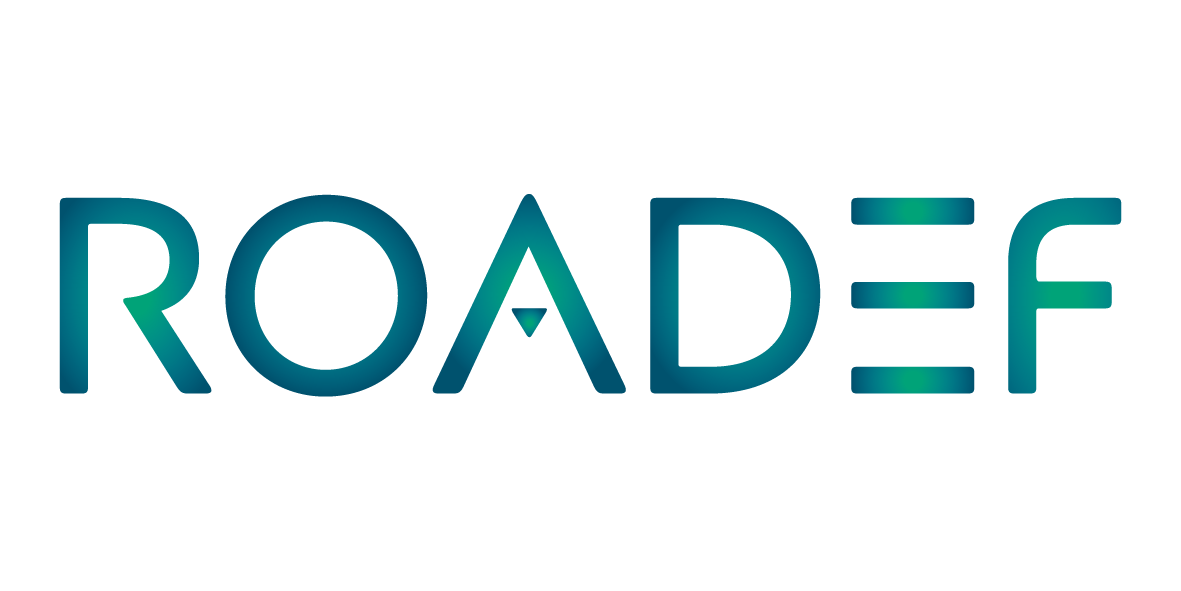ROADEF Challenge 2001: How to participate?
Summary
Information to be provided by the participants
General information
Participants in the ROADEF Challenge must provide the following information to the CELAR:
- description of the team:
- name(s),
- position(s) (student, post doc, professor, private sector employee,...)
- affiliation
- short description of the team and their past experience
- description of the methods used with motivation and references (less than 6 pages, in postscript format). Include the commercial software used and computer languages used.
- a table with the best solutions obtained along with the result files for the 15 problems. Include the characteristics of the machines and software used. Data to be provided in ACSII format.
- A program which will be used to rank the candidates. Either
- the C or C++ code including a manual for compiling, and the associated makefileallowing the CELAR to create an executable code, or
- a machine-independent executable code.
Candidates will be excluded for the following reasons:
- exceeding the deadline,
- incomplete dossier (any of the required elements missing),
- impossible to evaluate the code (problems in compilation or data formats, ...).
If the candidate wishes, his code can be accessible by internet.
Computer environments
The programs will be tested on a PC Pentium III à 500Mhz, RAM128Mo, equipped with:
- UNIX SCO 5.0.5 andr gcc version 2.95.2,
- Windows NT 4.0 with Microsoft Visual C++ 5.0 and gcc 2.95.2 and cygwin B20.
File hierarchies
- In UNIX SCO
- For a participant indexed NN, the file hierarchy is:
ROADEF/TESTSET/ scenario file*.in ROADEF/DOSSIER_NN/ sources (*.c et *.h), file readme, the makefile and/or the executable ROADEF/DOSSIER_NN/RESULTS/ result files *.out ROADEF/DOSSIER_NN/ARTICLE/ article (postcript) and result summary file (format ASCII)
- For a participant indexed NN, the file hierarchy is:
- In Windows NT
- For a participant indexed NN, the file hierarchy is:
(the reference of the disk is C, D or E) :
ROADEF\TESTSET\ fichiers scénarios *.in ROADEF\DOSSIER_NN\ sources (*.c et *.h), readme, makefile and/or the executable ROADEF\DOSSIER_NN\RESULTS\ result files *.out ROADEF\DOSSIER_NN\ARTICLE\ article (postcript) and result summary file (format ASCII)
- For a participant indexed NN, the file hierarchy is:
(the reference of the disk is C, D or E) :
Use of the executable
- Whether furnished or generated, the executable must be usable online
by typing:
- Name_executable name_file -t time
with:- name_file: scenario name. The program will look for and write to the files in the appropriate directories;
- time: run time in seconds.
The scenarios
Databases furnished by the Celar
Three scenario detabases will be provided :
- BASE A: 15 problems available from the outset of the challenge,
- BASE B: 15 problems provided later to be used for the 2nd round
- BASE X : 5 problems used to rank the 5 finalistes during the FRANCORO Conference.
Statistics on the scenarios
| Number of paths | 200 -3000 |
| Number of class 1 constraints | < 5000 |
| Number of CEM constraints | < 25000 |
| Size of the frequency domain | < 250 frequencies |
Evaluation and ranking
Candidates will be ranked in two categories:
- all projects selected by the jury,
- all student projects selected by the jury (a project is a student project if the majority of participants are students, possibly guided by their professors).
Timetable
There will be three phases.
- Phase 1:21/04/00 - 24/11/00 extended to
15/12/00
Over 7 months, candidates will develop and implement their algorithms on the TestSet A. The evaluation will be done on 5 problems from the TestSet A and the 5 smallest problems from the TestSet B. The maximum time to solve a problem is 1 hour (±10%). The 10 best candidates will move on to the second phase. - Phase 2: Pre-final -- 12/01/01 delayed
to 26/01/01 -13/03/01 extended to 23/03/01
Over the next 2 months the selected candidates can refine and test their algorithms on the TestSets A and B, and the evaluation will cover the full TestSets A and B. The maximum time to solve a prpoblem is 1 hour (±10%). The 3 best candidates will move on to the third phase. - Phase 3: FINAL and PRIZES
During the FRANCORO Conference in Quebec, May 2001, the finalists will each have 5 of the original scenarios (Base X). The winner in each of the 2 categories will receive a prize of 20,000 FF (3,049 Euros) accordedby the ROADEF.
Planning
- 21/04/00:
- Problems available on the WEB.
- 30/06/00 extended to 30/09/00:
- Application deadline of the candidates.
- Please to send your complete affiliations to
Van-Dat CUNG.
- 24/11/00 extended to 15/12/00:
- End of the Phase I, deadline for dossier submission with results.
- 12/01/01 delayed to 26/01/01:
- Phase I results announced, TestSet B problems available on the WEB.
- 13/03/01 extended to 23/03/01:
- End of Phase II, deadline for result submission on the 30 scenarios.
- 13/04/01:
- Results announced. Selection of the finalists.
- 9-11 May 2001 at FRANCORO III:
- Grand Finale on the TestSet X.
